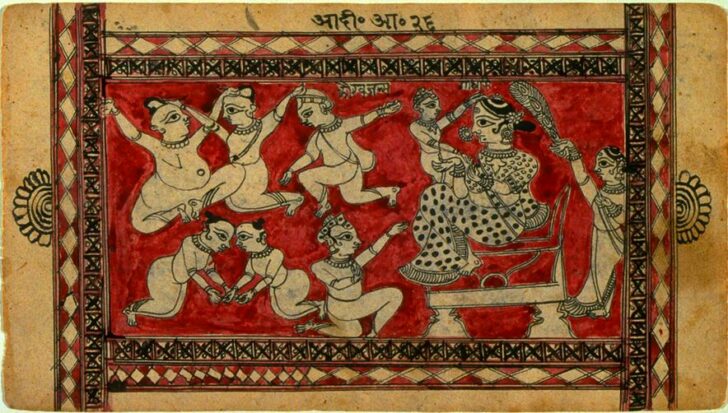The birth of the Kauravas from a Mahabharata series
Indian

Description
This scene comes from the first book of the Mahâbhârata an important early Hindu text and the most ancient of the great Indian epics. It tells the story of a rivalry between two clans of royal cousins, the Kauravas (the one hundred sons of Dhritarashtra) and the Pandavas (the five sons of Dhritarashtra’s brother, Pandu), that leads to a devastating war. Here Dhritarashtra’s wife, Gandhari, is seated on a throne and surrounded by her boisterous children. It is likely that one of the depicted children is Duryodhana, the man who would eventually lead the Kauravas clan in the coming war.
In India, folk paintings such as this are often the product of long traditions that change little across distances of time and space. Though the painting is on paper, the horizontal format mimics the shape of earlier manuscripts made from palm leaves. The style also has many parallels with earlier Indian painting.
Spring/Summer Gallery Rotation 2015
------------
In the Mahabharata, the most ancient of the great Indian epics, a rivalry between two clans of royal cousins leads to a devastating war. The two factions are the Kauravas (the one hundred sons of Dhritarashtra), and the Pandavas (the five sons of Dhritarashtra’s brother, Pandu). This scene of an early moment in the narrative depicts Dhritarashtra’s wife seated on a throne and surrounded by children. One can easily imagine that the artist drew on personal experience of boisterous children in his own household when he composed this lively scene. The horizontal format of this painting on paper mimics the shape of earlier manuscripts made from palm leaves.
Although this page dates to the nineteenth century, the assured quality of line here has many parallels to the style of earlier Indian painting. Folk paintings in India, such as this one, are often the product of long traditions that change little over distances of time and space.
Exhibited in "Divine Encounters, Earthly Pleasures: Twenty Centuries of Indian Art," 12/12/03-2/22/04.
---
In the Mahabharata, the most ancient of the great Indian epics, a rivalry between two clans of royal cousins leads to a devastating war. The two factions are the Kauravas (the one hundred sons of Dhritarashtra), and the Pandavas (the five sons of Dhritarashtra’s brother, Pandu). This scene of an early moment in the narrative depicts Dhritarashtra’s wife seated on a throne and surrounded by children.
Although this page dates to the nineteenth century, the assured quality of line here has many parallels to the style of earlier Indian painting. Folk paintings in India, such as this one, are often the product of long traditions that maintain continuity over distances of time and space. The horizontal format of this painting on paper mimics the shape of earlier manuscripts made from palm leaves.
(6/28/10)
(South and Southeast Asia Gallery Rotation, Spring 2010)
Subject Matter:
Gadhari, daughter of the King of Gandhar and wife of Dhritarashtra, was blessed by Rishi Vyasa to have 100 sons. She was pregnant for two years, and finally gave birth to a mass of flesh. Vyasa instructed her to cut the flesh into 101 pieces and places them in jars, one for each of 100 sons and one for a daughter. In two more years, the jars provided her with her 101 children of the Kaurava clan.
Physical Description:
A scene takes place in a red box, lined with black and red diamond and triangle designs for borders. In the center, a woman sites with a child in her lap. She wears a spotted dress, her hair up, and a nose ring and bindi. The child reaches one hand and places it atop her head, and the other down towards her own upward hands. Surrounding them are seven other figures. One kneels before them, offering his hands up, and another fans the woman from behind. The remaining five figures seem to play together in front of the throne on which the woman and child sit.
Usage Rights:
If you are interested in using an image for a publication, please visit https://umma.umich.edu/request-image/ for more information and to fill out the online Image Rights and Reproductions Request Form.